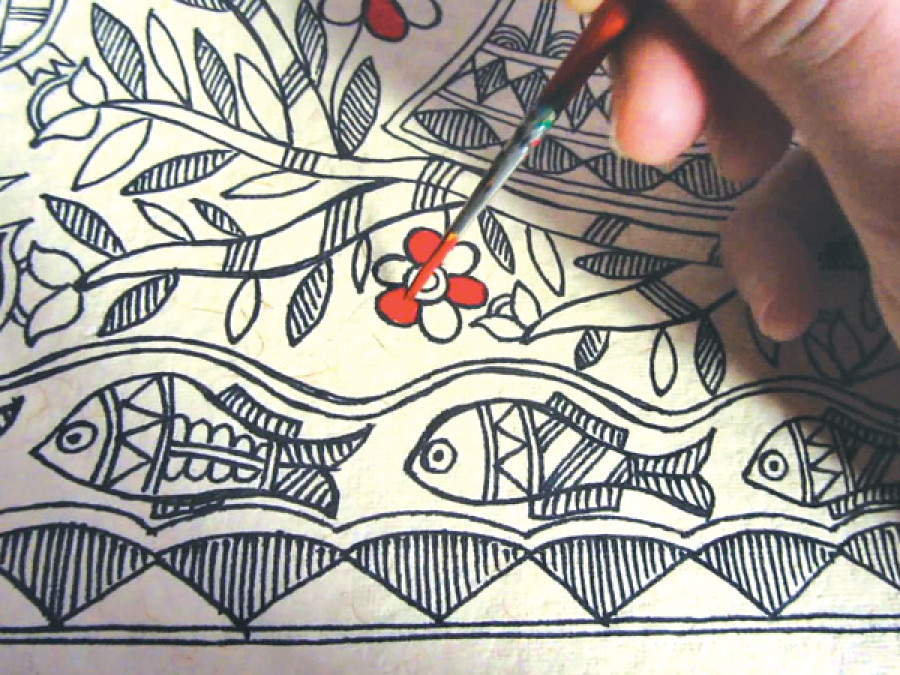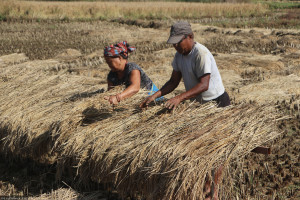Miscellaneous
Art of Mithila: A living tradition
Bharati Dayal offers her creative repository to art enthusiasts through her book Madhubani Art
Madhubani painting, a representative form of Mithila art, has its origin in the great Indian sub-continental epic Ramayana where it is believed King Janaka of Mithila hired local artists and decorated the town of Janakpur with this unique art form for the wedding of his daughter Sita to Rama.
The Maithils are Shakti (mother goddess) worshippers—and the schools of Tantric rituals have been flourishing in their surroundings, giving spiritual traction to an informal art form that soon became a living tradition.
Bharati Dayal, a keen practitioner of Madhubani painting, features divine forms and narratives in her works. She offers her creative repository to art enthusiasts through this elegantly produced book. This book showcases some of the best paintings of Bharati Dayal and re-confirms that she is an artist who has indeed played a significant role in the re-emergence and spread of this ethnic art form. Her paintings get completed in a diversely rich combination of graphic designs, tattoos, lines, concentric circles, motifs of flora and fauna, spirits and animistic renderings—exuding figurative intents. The beautiful collection of her paintings in this book, which is a treasure trove for art lovers, keeps supreme value in the paintings’ geometric patterns and divine imagery.
As reflected in the basic forms of Mithila painting, artists have tried chasing the effects of divinity in their paintings; thus, gods and goddesses frequent artistic interpretation. This shaping of the distinct style could be attributed to the intricacy of Maithil societies, in which, until a few decades ago, women artists lived in small circles.
Initially, the different variants of Mithila paintings were done on walls coated with mud and cow dung, nevertheless, it never lacked precision in bringing to fore the symbolic representation, which effectively gives it its uniqueness.
Maintaining consistency, the different genres of Mithila painting depicted an assembly of symbolic images of the lotus plant, bamboo groves, fish, birds and snakes in union. These images particularly represent fertility and longevity of life.
When technically evaluating, Mithila paintings can be divided into five distinctive styles: Bharni, Katchni, Tantrik, Nepali and Gobar. Until the 1960s, when Mithila paintings were not yet commercialised, Bharni, Kachni and Tantrik style were mainly done by Brahman and Kayashth women, who are the upper caste women in India and Nepal.
Their themes were mainly religious, but in the course of time, this caste hierarchy was broken down and participation became much broader. With that, new dynamics entered in Mithila painting—and other aspects of life were included in its fold. For example, the Godna and Gobar style was made popular by the Dalit artists.
Mithila painting, although preserved through customs, was largely unknown to the outside world until the deadly earthquake of 1934 that ravaged the areas near India-Nepal borders. The mode of livelihood that was dependent upon local factors, suddenly strained to cope with deep humanitarian crisis in the aftermath of the earthquake. In those testing times while inspecting the damages, William G Archer, then a British colonial officer posted in Madhubani Sub-division (then under Darbhanga district), came across the paintings on the newly exposed interior walls of local homes which had been severely affected by the earthquake. What he found remarkable in those paintings was a striking similarity with the work of modern Western artists such as Picasso and Miro. Archer was the first observer of Mithila painting, who took pains to take black and white photographs of these folk paintings in the 1930s—those are today the earliest images of Mithila Painting.
He even wrote about the painting in an article in the magazine Marg, an Indo-Nepal Art Journal, in the year 1949. In the hardship that was furthered on the locals by frequent drought and famine, especially the drought from 1966 to 1968, the agricultural economy of the region was severely damaged. Amidst the odds, a senior Congress leader and stalwart of Maithil politics, Lalit Narayan Mishra (then a Union Cabinet Minister in India) put enormous effort to heal the suffering of that region by promoting Mithila paintings as commercial art.
In order to bring economic relief to the region, Pupul Jayakar, the then Director of the All India Handicrafts Board, sent the Bombay-based artist Bhaskar Kulkarni to Mithila to encourage women there to replicate their murals on paper which would facilitate sales and provide a source of income. Here started a commercial movement in Mithila art; it was now being seen as a source of gainful engagement, especially for women who had no other occupational entitlements.
It is worthwhile to recall the rich contribution of foreign scholars in promoting Mithila painting internationally. Yvesh Vequad, a French novelist and journalist, in the early 1970s wrote a seminal book on the subject The Art of Mithila: Ceremonial Paintings from an Ancient Kingdom—and produced a film, titled The Women Painters of Mithila.
His contemporary Erika Moser, a German anthropologist and film-maker, persuaded the marginalised ‘Dusadh Community’ to paint and capture their oral history (including of Raja Salhesh and Rahu). Thus came in a new form of Mithila painting, influenced with bold compositions and figures, based on tattoo patterns, locally called Godna. This further flourished the art scene in Mithila.
The livelihood of women artists further strengthened through the efforts put by Moser and Raymond Lee Owens. In 1977, Gauri Mishra took the lead to set up the Master Craftsmen Association of Mithila, working in collaboration with Ethnic Arts Foundation of USA.
Viji Srinivasan, then a programme officer with Ford Foundation, and who later set up an organisation Adithi, headquartered in Bihar and worked on women’s issues including livelihood through handicrafts, also played a role in nurturing the concepts of cluster. Since the 1990s, Japan has also shown a keen interest in Mithila Paintings, mainly because of the initiatives of Tokyo Hasegawa, who set up the Mithila Museum in Tokamachi, where around 850 Madhubani paintings are exhibited on a regular basis.
Among those Indian scholars, who contributed to the stream of Mithila Painting, are: Mulkraj Anand (a book on Madhubani painting), Devaki Jain (numbers of papers on Mithila art) and Jyotindra Jain (a fine book on legendary artist, Ganga Devi); they traveled across the hinterlands of Mithila to comprehend the artistic genesis and the issues on ground.
Today, when Mithila painting as an art form is creating livelihood opportunities across the border of India and Nepal, it becomes more imperative than ever to unleash its true potential. The further scope of its exploration is immense, and as it is globally recognised now, its expansion in the course of time will make the women of Mithila drawn towards art entrepreneurship. Much is being done in this regard in Janakpur in Nepal and in Madhubani in India, to prepare for the next round of commercialisation.
The dynamic changes in the Mithila region are overtly transforming the ways to look on its beautiful art tradition where today the passion in art is being linked with entrepreneurship. Remarkably, women have a lead here.




 16.12°C Kathmandu
16.12°C Kathmandu









